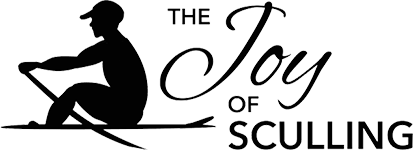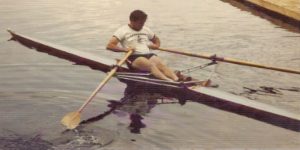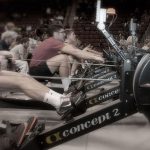High Performance Mind
High performance relates to the full spectrum of the rowing world from the novice to the elite athlete. For the athlete and the coach it is a clear state of mind that resides almost totally in the present moment. It relies heavily on the instinctual and intuitive mindsets. Feeling and seeing are extremely important elements in this mode of thinking. However, it is the drive for clarity and simplicity that are so essential for performance at whatever level. But, as 21st century humans we want things in fragments. “That way we don’t have to think about our inconsistencies.” However with this mindset we are thinking whole and we carry and project this thinking into other facets of our living. The striving for the clear open mind and seeing connections between things becomes our odyssey. Every movement is easily monitored under this state of mind. In sculling this mindset is assisted when we are looking for smooth muscle action in the smallest of the parts of the movement, the wrists and fingers. We reach a point in our mental development where we can see each of these movements.It is part of our inner eye, the Mind’s Eye. This is our inner eye at work that has to be recognized and cultivated. We are working with the eye that can see itself. Our whole body is clear, simple and open. It demonstrates a rational approach to sculling and life. Like Gilbert K. Chesterton, the Apostle of Common Sense in the last century, we follow our common sense when approaching the coaching of sculling. Latest champion is not necessary the best model to follow.
Take a look at the above picture and see how common sense plays a part in the skill. The trunk and legs finish together making a one of two punctuation marks in the cycle. They form a nice angle for stabilizing the finishing draw of the arms to the body and continue that support as the arms move away from the body to the straight arms. The trunk remains throughout this slight pause in the stroke cycle in a perfectly upright position keeping the body weight off the bow. The blades are extracted smoothly and cleanly. The wrists remain flat as the fingers perform most of the work. The movement of the handles out of bow originates at the elbows, so, “it is elbows in, elbows out.” Finally, this picture perfectly represents the end of the drive where the legs and trunk finish together with the hands trailing slightly. The movements all make perfect sense.
In doing so, we are totally connected to the world around us and inside of us. The mind is a beautiful clean slate. Every particle is operating as a whole and every system in our body is fully organized and integrated within and without itself. Everything about this release and follow through is fully connected and integrated.
Thus the competitive situation simply becomes engulfed by the clear mind of common sense doing. There is no place for ego, no concern over speed development, no need to try to best your opponent. We are simply trying to perform at our best. There is no concern for goal setting and objectives. Your mind rests in the present and on yourself. I picture it as steady flowing stream between your sculling and stepping out of the shell gracefully into your daily life. Mind is quiet, highly concentrated and conscious of the world around us. We are simply being.
For so long we have operated with a competitive mind pitting the athletes against each other. We forget that competition requires cooperation. The cooperation involved within our own bodies and the operation between the competitors to do their best. We can counter this competitive mind with its ego involvement and the aggressive striving by simply remembering, “to pull what you can handle.” This little phrase covers a lot of ground. We don’t try to operate at 120%. We simply work at a level that our bodies can handle.
According to Fitzpatrick and Pocock the drive is executed as one piece. There is no fragmenting into the legs, trunk and arms. It is an integrated whole from the entry to the release.
One of the important qualities of great coaching is having a vivid imagination. I think George Pocock epitomized this quality. He was not involved with interminable paperwork, and the numbers associated with the modern ergometer so that his imagination was not stifled. His expansive mind concentrated on his boat building, his coaching and his poetry. He valued his command of the English language and his English heritage from the Thames Valley. He was able to see things in the athlete’s technique and temperament because of this vivid imagination that others failed to see. So for the Washington 1936 Olympic crew George was the person in large part that was responsible for placing Joe Rantz in the all-important number seven seat. He could see the value of Rantz. He recognized the potential in Joe. For George, his wisdom came from his working with wood where he could feel and see the value of the material in his hands. When he was able to get Joe Rantz to concentrate on his rowing from the seven seat, the eight became more fluid and Flowed.
Under Fitzpatrick’s coaching the athlete was on his own as Fitzpatrick was not permitted in a coach boat. So the athlete was left to his own imagination and to his own mind. It was quite the training that he went through. He was forced to try to see the stroke in his own mind. Fitzpatrick referred to this as the Mind’s Eye.
The other coach who comes to mind is the late Allen Rosenberg. His imagination surfaced in the vivid metaphors that he employed to describe the stroke cycle. It was his imagination at work and was influenced by his legal profession and extensive reading.
The imagination permits you to see the world differently every day of your life. There are worlds within worlds. It allows your mind and spirit to soar. It allows you to seek movements in the stroke cycle that are much more subtle and refined. These days I try to spend more time in this other world, this imaginative world. On our scale, for the coaches there are techniques within techniques in each athlete waiting to be squeezed out into the open. You only have to see them. You only have to refine them. My friend Vince is doing a great job of refining his skills both externally and internally.
The imagination, visualization, allows you to see the sculler’s entry, the glide forward from the hips on the recovery, the smooth five movement release, and the whole body drive with the salt shaker movement. Visualization is the key to ingraining the movements into your body structure. The coach, also, must engage their imagination in order for the movements to become part of their mind and body. I can still picture the old coach working with me to produce a fluid, continuous stroke cycle. The use of the metaphor becomes extremely important.
From my youth the picture of the workers cutting the long grass beside the Canadian National Railway line with the two handed scythe comes to mind. They display great skill as they worked their 8-10 hour day. Even today I can easily visualize their almost magical movements they employed with their scythes. My mind returns to a moment that took place over 70 years ago on the grassy banks of the Canadian National Railway.
We must trust our youthful ability to image and protect these vivid images. I can see this quality in the imaginative play of my grandchildren. It is wonderful to behold. This experience will surface in our coaching as we set ourselves in a different world. This world does not include the drudgery of paperwork, recruiting concerns, adhering to the timelines of the periodization plan, or the overemphasis on the ergometer score, all of which leads to staleness and mundaneness of thought. We are seeking a lively, and imaginative mind for our coaching. This active imagination leads one to the high performance mind. It is with this mind that the coach has to present the various movements of the stroke cycle to their athletes. It must be completed with a rational and common sense mind.
The development of the coach’s mind and the expansion of their consciousness must proceed step by step with the athlete’s mental development. Everyday comes with a new revelation about the sculling stroke and this leads to a growth in our consciousness. So the stroke itself and our awareness of it, is part of our development.


















